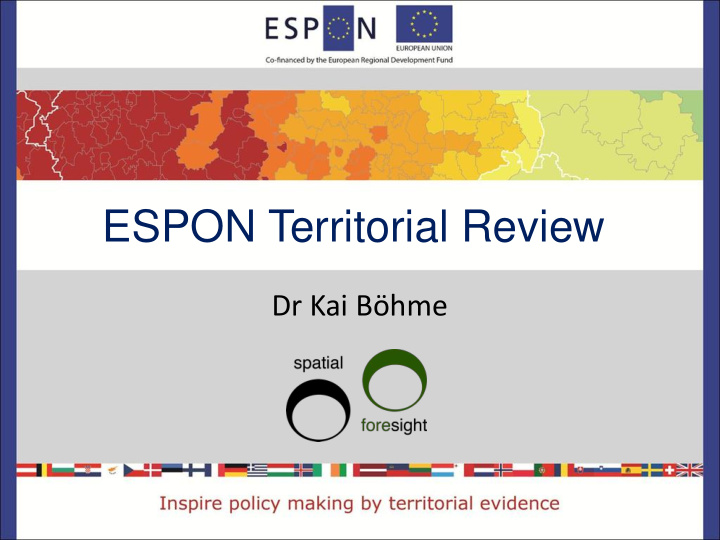



ESPON Territorial Review Dr Kai Böhme
Key messages
Think functional areas & links Functional areas of different size and character shape territorial development in Europe: Functional urban regions • Functional rural regions • Functional urban-rural partnerships • Cross-border regions • Transnational / macro-regions • Europe • Europe and its neighbourhoods • Links between functional areas are a lever to unlock potential and address challenges: Trade • Migration • Cooperation •
European disintegration has no winners
Key messages for ESIF post 2020 Interdependencies of places shape Europe's development Functional areas of different geographical size matter • (functional urban areas, cross-border regions, macro-regions … ) European disintegration has no winners in Europe • Challenges cannot be solved by territories individually • For all development themes cooperation is a must, not a luxury • Policy pointers for Cohesion Policy post 2020 All operations need a clear element of territorial cooperation • All programmes need elements of territorial cooperation • Plan and implement investment initiatives at functional area level • Mainstream territorial cooperation in the ESIF post 2020 Think beyond Interreg •
Territorial evidence
Territorial concentration trends Territorial concentration of population Focus on western and northern Europe and metropolitan areas • Sub-urbanisation processes • Challenges in shrinking regions and (inner peripheries) • Increasing concentration of economic activities Concentration of GDP growth • Metropolitan areas are performing better than other types • Increasing social inequalities • Technology and innovation as potential game changer 4 th industrial revolution accelerates territorial differences • Urban areas in northwest Europe as innovation locations • Circular economy innovation even more concentrated • Decreasing agglomeration advantages and increasing sprawl •
Territorial links and interdependencies Flows to urban centres shape our daily routines SGI flows to regional centres • Sharing economy, new types of flows mainly to urban centres • Flows to main hubs shape the boarder picture Knowledge – global network society • FDI – impact highest in urban areas • Freight – growing volumes and hubs • Migration – accelerating territorial concentration trends • Labour migration – ‘soft flow back’ dimension •
Territorial cooperation needs
Cooperation needs Functional urban/rural areas & cross-border regions Addressing aging and demographic change • Integration of labour markets • Strengthening the knowledge economy • Providing governance frameworks allowing SMEs to grow • Enhancing productivity spill over of FDIs • Boosting renewable energy production and consumption • Reaching critical mass for boosting the circular economy • Creating industrial symbiosis processes • Transport services at the level of functional regions • Provision of daily SGIs •
Cooperation needs Macro-regions / transnational regions Dealing with intra- and extra European migration • Managing refugee flows across borders • Cushioning territorial centralisation in the knowledge economy • Finding the right complementarities between regions • Ensuring transmission infrastructures for renewable energy • Development of centralised structures for a circular economy • Reaching critical mass for sectors boosting new technologies • Provision of specialised SGIs, especially e-services • Transnational ICT solutions •
Cooperation needs Need to map cooperation needs and efforts Detailed analysis of territorial interdependencies at • European level European cooperation patterns and network analysis for • territorial development
… there is more to it … More evidence Pointers & for a Tailor-made ESPON territorial Territorial Reviews dimension of at ESIF www.espon.eu post 2020
Your tailor made Territorial Review
Your tailor made Territorial Review
Dr Kai Böhme Spatial Foresight 7, rue de Luxembourg L-7330 Heisdorf +352 691 87 32 49 kai.boehme@ spatialforesight.eu
Recommend
More recommend